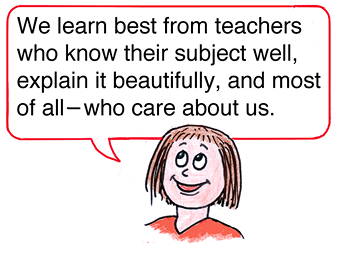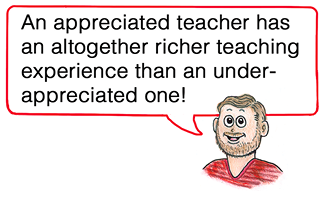Focus on Physics
A Personal Journey to Classroom Success
The Science Teacher—January/February 2022 (Volume 89, Issue 3)
By Paul G. Hewitt
For me and my teacher friends, physics teaching is the ultimate profession. Astronaut Scott Kelly has been quoted as saying that next to being an astronaut, his career choice would have been teaching first-year college physics or calculus. But teaching isn’t for everyone. Success in the classroom depends very much on student-teacher interactions.
Success in the Classroom
Being a successful teacher means understanding your subject well, presenting clear explanations, and having a knack for making complex material simpler to grasp. All this needs to be coupled with a positive attitude toward students, an attitude that is likely matched by student attitudes toward you. Being a successful teacher means being greeted with student smiles. You may find you are more than just appreciated; perhaps you are loved by your students. Teaching, indeed, can be an extremely satisfying career.

Lack of Success
Then there are your unsuccessful colleagues, too often treated with indifference by their students. They likely entered the teaching profession with high hopes. They know their subject matter, but perhaps lack the knack for clear explanations, and unintentionally make simple topics complicated. They simply don’t cut it with their students. The cooperative relationship they hoped for turns into an adversarial one. They feel unappreciated and have a diminished love of teaching. Some “burn out” and either leave academia or move into administrative positions.
Shyness and Fear in the Classroom
I submit that in most cases, this can be turned around. Classroom success is seldom immediate. Mine wasn’t! A lot of time and effort went into making it look so easy. My steps to effective teaching began in graduate school as one of three teaching assistants who met twice a week with small groups of students to go over homework and coach problem solving to complement a professor’s auditorium lectures. I had a serious problem—I was shy. On my first day I nervously faced about thirty freshman students. I tried my best not to appear terrified and managed to deliver material I’d worked on feverishly the night before. It went quicker than planned so I dismissed the class earlier than the usual 50 minutes.
Overcoming Inhibitions
Even the most timid person would have no trouble shouting “fire!” in a burning theater because the information is important. If what I spoke of in classrooms were received as important information, my shyness would be much reduced. My solution was to work on delivering only relevant and valued information to the class. Earning student approval seemed to require that every spoken word be useful to them. If I were good at explanations, I could remain composed while teaching. I prepared vigorously, making sure to untangle perceived obstructions to clear problem solving. I became good at it, and the students became happy with my teaching. Whew! If I had not been good at it, if I had not gained classroom respect, I would have reconsidered my teaching career.
Step-by-Step Explanations
After earning the required master’s in physics for teaching, I began my teaching career at City College of San Francisco. Intent on wanting to become a more-than-good teacher, I devoted enormous effort to creating and developing polished lessons. To that end I’d be sure that an idea I wished to convey was preceded by easily understood information, often with an analogy. As with writing code for a computer program, I created step-by-step sequences of material, knowing that if I left out key elements, nothing would gel. Extra preparation was the key. I often arrived at school early when the lecture hall was vacant, to quickly go over the tougher parts of a lesson on the chalkboard. Practice greatly clarified my delivery. Timing was also important. Too slow or too fast was to be avoided.
Love Your Students
Another ingredient of successful teaching is to consider your students as a classroom family—to love them. Many students have serious problems, ranging from relationships with classmates at school, to family struggles, or myriad other problems that get in the way of success in their studies. Feeling cared for, heard, and respected in your class helps immensely. Furthermore, if they feel that you care for them, they’ll learn from you. If they sense that you don’t care for them, they don’t learn, even from well-delivered presentations. An uncaring teacher doesn’t earn their appreciation. As with Newton’s third law, love is one part of a two-way interaction. If you love your students, they’ll love you. Being loved is being appreciated.
.png)
Being Appreciated
There are some central rules to heed in order to be an appreciated and effective science teacher:
- Attitude: Consider yourself your students’ coach. You’re there to guide their study, keep them focused on essentials, help them understand, and minimize time-draining peripherals. Strive for them to view you as someone to help them learn—not as their inquisitor.
- Do less professing and more questioning and listening. Bring questioning into your presentations by asking students to check with their neighbors to share ideas, and listen carefully to their responses and thoughts. Make adjustments as needed before continuing on to new material.
- Not knowing everything is okay. If there are times when you’re confronted with a question you can’t answer, don’t fake it. The students can tell! Fudging shows. Better to say, “I don’t know. How could we find out?”
- Pace your class well. Information delivered and reviewed too quickly is frustrating to students. Before advancing to new material, check to see if covered material is understood, especially if new material builds on it. Otherwise you’ll be talking to yourself.
- Exam coverage. Ensure that your exams cover the material being presented. Test what’s important and don’t test less important material. Don’t leave out important topics. How frustrating it is for the student who put extra effort into studying material to find that it doesn’t show up on the exam.
- Don’t frown on the notion of “teaching to the test.” What’s on the test defines what’s important.
- Exam fairness. Create exams on which your best students earn a perfect or near-perfect score. If your brightest students score low, either they haven’t learned as well as you imagined, or your exam may be unfair—perhaps designed poorly or simply too difficult. Making good ones is an art. Become adept at this art.
- Grade exams in a timely manner and post scores quickly. This reduces student anxiety, which students appreciate.
- Respect is a two-way street. Show respect for your students. Although they all know less physics than you do, some are more intelligent. Underestimating their intelligence would be overestimating your own.
Patience and Practice
As in many professions, patience, practice, determination, and a strong work ethic underscore success. Given time, the slowest of learners can master a craft. I’m an example of that. Being a slow learner has been an asset to my teaching. Not grasping the essence of an idea right away instills a patience with students who similarly need time to learn. On the other hand, faster-learning teachers may incorrectly assume that if students just hear something stated they’ll remember it, wrongly thinking they will have learned it. Given practice and patience, both fast and slow learners can succeed in a field of study that is satisfying in so many respects. Cheers to those who adopt enough patience to become a successful teacher.

Acknowledgment
I thank my friend Ken Ford for editorial suggestions and for his lifelong love of students in the classroom. At age 80, when receiving AAPT’s highest teaching award, he responded with his essay “Love Them to Death.” Great teachers love their students.
On the Web
On www.HewittDrewIt.com are two screencasts for teachers, 148 student-oriented tutorial lessons covering a broad swath of physics, and links to related materials. See also www.ConceptualAcademy.com.
Paul G. Hewitt (pghewitt@aol.com) is the author of Conceptual Physics, new 13th edition; Conceptual Physical Science, 6th edition, coauthored with Leslie Hewitt and John Suchocki; and Conceptual Integrated Science, 3rd edition, with coauthors Suzanne Lyons, John Suchocki, and Jennifer Yeh.
Physics Teacher Preparation Teaching Strategies High School


